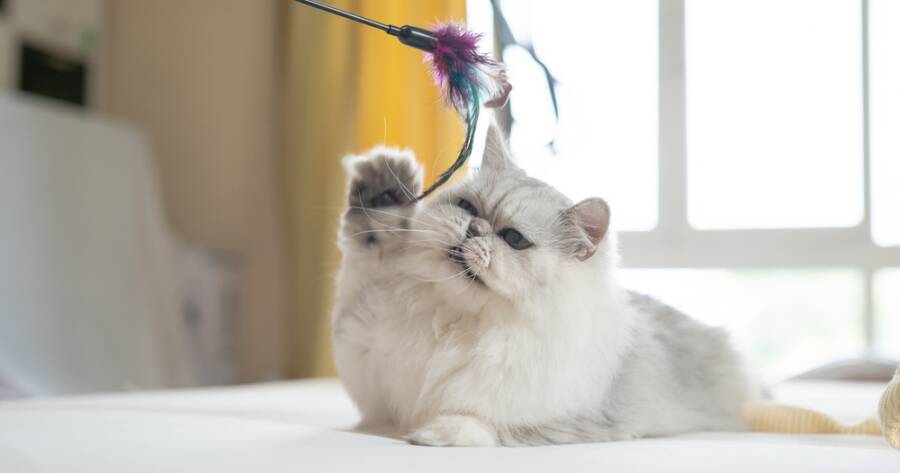Indoor cats may live safer, longer lives but without enough stimulation, they can get bored, restless, and a little destructive. If your furniture is under attack or your cat is climbing the curtains for fun, it’s time to rethink playtime. Keeping your feline friend mentally and physically engaged doesn’t require a full-on jungle gym, just a few clever strategies and interactive toys to channel their natural instincts and energy into fun, healthy behaviors.
Provide Plenty of Climbing and Scratching Options
Cats love to climb! It’s instinctive, stimulating, and gives them a sense of safety and control. If your cat doesn’t have a place to climb, they’ll likely invent one (hello, top of the fridge). Invest in a cat tree, wall-mounted shelves, or window perches to give your cat vertical space that’s just for them.
Scratching is equally important and completely natural. It helps cats stretch, mark territory, and shed old claw sheaths. Rather than scolding them for scratching the couch, provide scratching posts in multiple locations. Try different materials like sisal, cardboard, and carpet to find what they love. With the right outlets, your cat can climb and scratch to their heart’s content—without destroying your decor.
Rotate Toys to Keep Things Fresh
Cats get bored with the same toys day after day. Instead of dumping all their toys out at once, try rotating a few different types in and out each week. This keeps things exciting and encourages curiosity, even if they’ve played with the toy before. Think of it like a toy box “refresh” to re-engage their interest.
Use a mix of textures and movements, think feather wands, crinkle tunnels, plush mice, and battery-operated toys that mimic prey behavior. You don’t need a huge toy budget either; a cardboard box, paper bag, or crumpled ball of foil can be surprisingly entertaining. Switching up their toy selection regularly helps prevent boredom and keeps your cat mentally stimulated.
Schedule Daily Play Sessions
Interactive play is one of the best ways to engage your cat and strengthen your bond. Set aside 10–15 minutes once or twice a day to play using wand toys or laser pointers. Mimic the motions of birds, bugs, or mice—short bursts of movement, followed by stillness—to tap into your cat’s natural hunting instincts.
These play sessions help burn energy, reduce anxiety, and provide structured stimulation. Finish each session by letting your cat “catch” the toy to avoid frustration and give them a sense of satisfaction. Not only does this tire them out, but it also often prevents behavioral issues like aggression, overgrooming, or nighttime zoomies.
Use Food Puzzles and Treat-Dispensing Toys
Feeding time can be more than just a routine, it can be enrichment! Food puzzles, slow feeders, and treat-dispensing toys encourage cats to problem-solve and “hunt” for their food, mimicking how they would eat in the wild. This adds a layer of mental stimulation to their day and keeps meals from being over in a flash.
Start with simple toys like a treat ball or muffin tin with hidden kibble, then gradually introduce more complex puzzles. You can even hide small portions of their food around the house to turn mealtime into a fun scavenger hunt. These activities engage their brain, promote healthy eating habits, and help curb boredom in indoor environments.
Stimulate Their Senses with Bird TV and Scents
Cats are visual and sensory creatures. Consider setting up a perch near a window where they can watch birds, squirrels, and the outside world. If you don’t have a wildlife-heavy view, try playing “cat TV” videos on YouTube, many cats will sit and watch for hours.
Scents also play a big role in enrichment. Catnip, silvervine, or even a sprinkle of valerian can liven up an old toy or scratching post. Rotate different scent-based experiences to keep your cat’s environment engaging. Just like us, cats enjoy a change of scenery or, in this case, smell—and these little adjustments can have a big impact on their mood and behavior.
Create a Cat-Friendly Environment
A well-thought-out environment is key to preventing boredom and mischief. Make your home an adventure zone by adding cozy hideaways, tunnels, and high-up napping spots. Give them quiet places to retreat and sunny spots to nap. The more a space feels like their own, the less likely they are to act out.
Don’t forget safety! Tuck away cords, secure fragile items, and block off areas that could be dangerous. When your cat feels secure and stimulated in their space, they’re happier, more confident, and much less likely to channel their energy into clawing the couch or scaling the curtains.
A Happy Cat Is a Busy Cat
Keeping your indoor cat entertained is about more than avoiding shredded sofas, it’s about nurturing their curiosity, instincts, and overall well-being. When you provide engaging activities, thoughtful spaces, and a little one-on-one playtime each day, you help your cat thrive emotionally and physically.
A stimulated cat is a content cat, and a content cat is far less likely to turn your furniture into their playground. The effort you put in now leads to a happier, healthier feline—and a more peaceful home for you both.

